LettsRetreat is offering a rare opportunity to experience the stunning Mamhead Park South estate through an exclusive subscription-based membership. Subscribers who commit to either a monthly subscription (after 10 months) or an annual subscription will be entitled to a complimentary 5-day stay per year, with full access to the historic estate.
Mamhead Park South, a hidden coastal gem nestled in stunning Devon countryside, offers a different take on luxury. This historic estate has been lovingly rewilded, blending opulent living with the tranquility of nature. As you explore the grounds, you'll find ancient woodlands, lush meadows filled with wildflowers, and scenic walking paths that invite relaxation and reflection.
This isn’t just a retreat—it's an eco-luxury experience. Rewilding efforts at the estate have transformed manicured landscapes into thriving natural habitats, where wildlife flourishes. Birds such as red kites, kingfishers, and woodpeckers soar through the skies, while water voles, herons and mallards make their homes.
Subscribe today to LettsRetreat+ and secure your 5-day annual stay at this extraordinary estate. Experience Mamhead Park South in its entirety, from the majestic woodlands to the serene gardens and all its hidden corners of beauty.
Subscribers can fully immerse themselves in the estate's beauty, enjoying the serene gardens, the charm of the Lakehouse at Devon Sculpture Park, and the surrounding wildlife. Whether you seek peace, renewal, or a deeper connection to nature, Mamhead Park South offers a sanctuary like no other - a place where history, art, and nature harmoniously come together.
The Robert Adam Orangery offers a sublime blend of historical grandeur and natural beauty. This enchanting estate, with its sweeping lawns, ancient woodlands, and panoramic views over the Exe estuary, is a true sanctuary. A majestic tree-lined driveway welcomes you into a world where heritage meets serenity, leading to the Orangery, a Grade II* listed coastal gem that exudes timeless elegance.

The architecture, with its grand façade, ornate stonework, and tall, mullioned windows, evokes a bygone era of opulence and sophistication. Inside, high-ceilinged rooms filled with soft natural light open onto terraces and gardens with breathtaking views to the sea below, offering tranquil spaces for both reflection and celebration. The estate’s parkland stretches for miles, with secluded walking paths winding through the lush greenery, alongside Capability Brown gardens dotted with centuries-old trees.

Tucked within the enchanting grounds of Mamhead Park South, the Lakehouse offers more accommodation and a serene hideaway where art, nature, and conservation converge. Perched on the edge of a small shimmering lake, this charming retreat is surrounded by wildflower meadows, ancient woodlands, and undulating hills that have been carefully nurtured through an ambitious rewilding project.
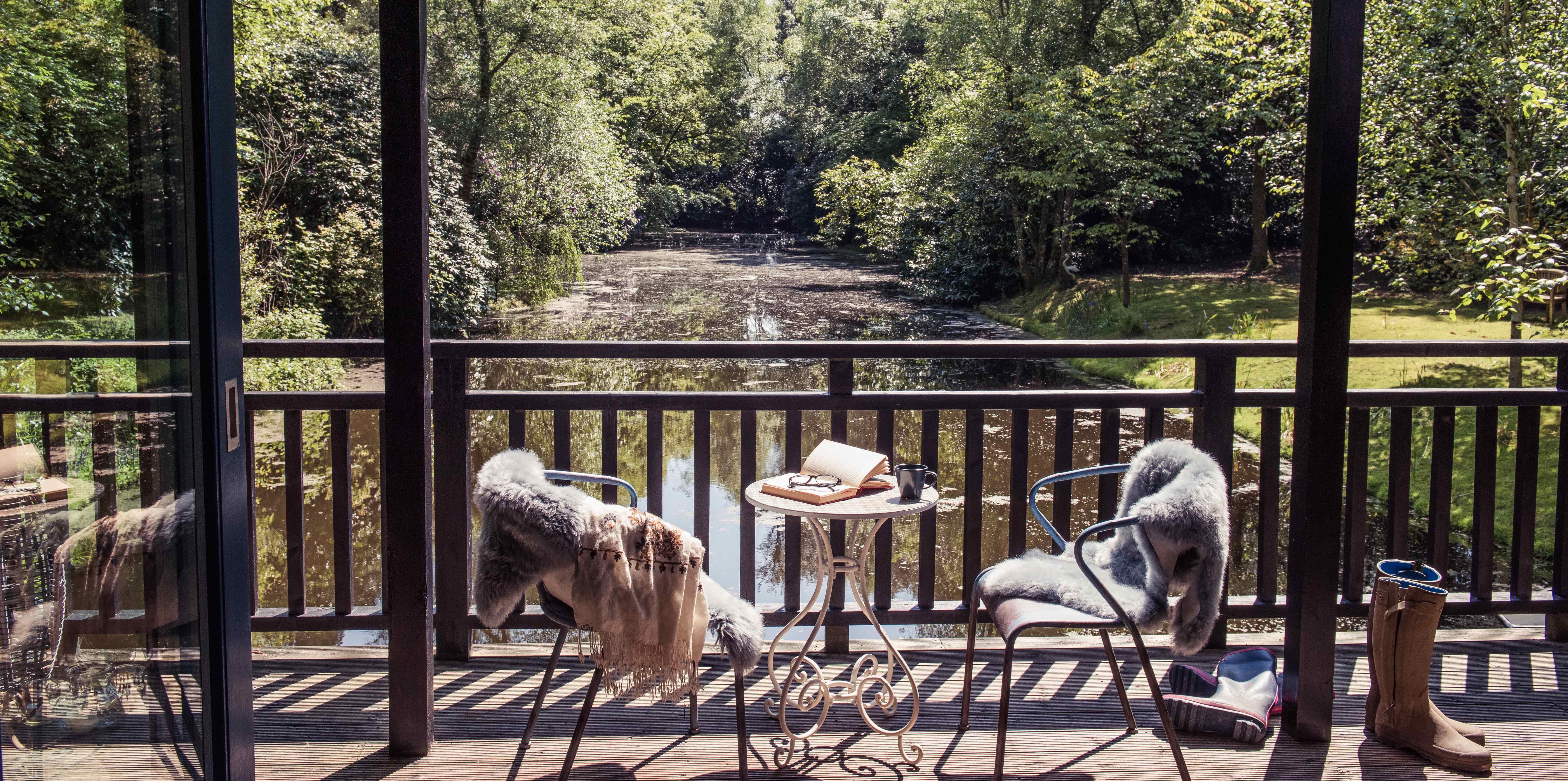
Make this stunning eco-retreat your personal haven each year. Subscribe to LettsRetreat now and claim your annual 5-day stay at Mamhead Park South - your chance to relax, renew, and restore in this peaceful rewilded estate.

As you retreat to the Lakehouse hovering over the lake, you’ll be immersed in a world where art and nature exist in harmony, surrounded by the tranquil beauty of Devon Sculpture Park’s extraordinary rewilded landscape. It’s a place to reconnect with the wild, to experience the serenity of nature’s revival, and to embrace the quiet magic of this unique sanctuary.
Don't miss out on this exclusive opportunity! Subscribe to LettsRetreat+ today and unlock your annual 5-day stay at Mamhead Park South, where luxury and nature meet in perfect harmony.

The Estate comfortably sleeps 14 people in 6 bedrooms between The Orangery and the Lakehouse. And includes ample space for dining and relaxing on its large terraces and decks with stunning sea views or intimate settings over the magical copse that surrounds the lake.
Enjoy the full estate for a family gathering, an adventurous offsite or a chance to gather with old friends. Explore all its diverse attributes from architecture, art, garden. Its the ultimate place to relax, renew and restore.
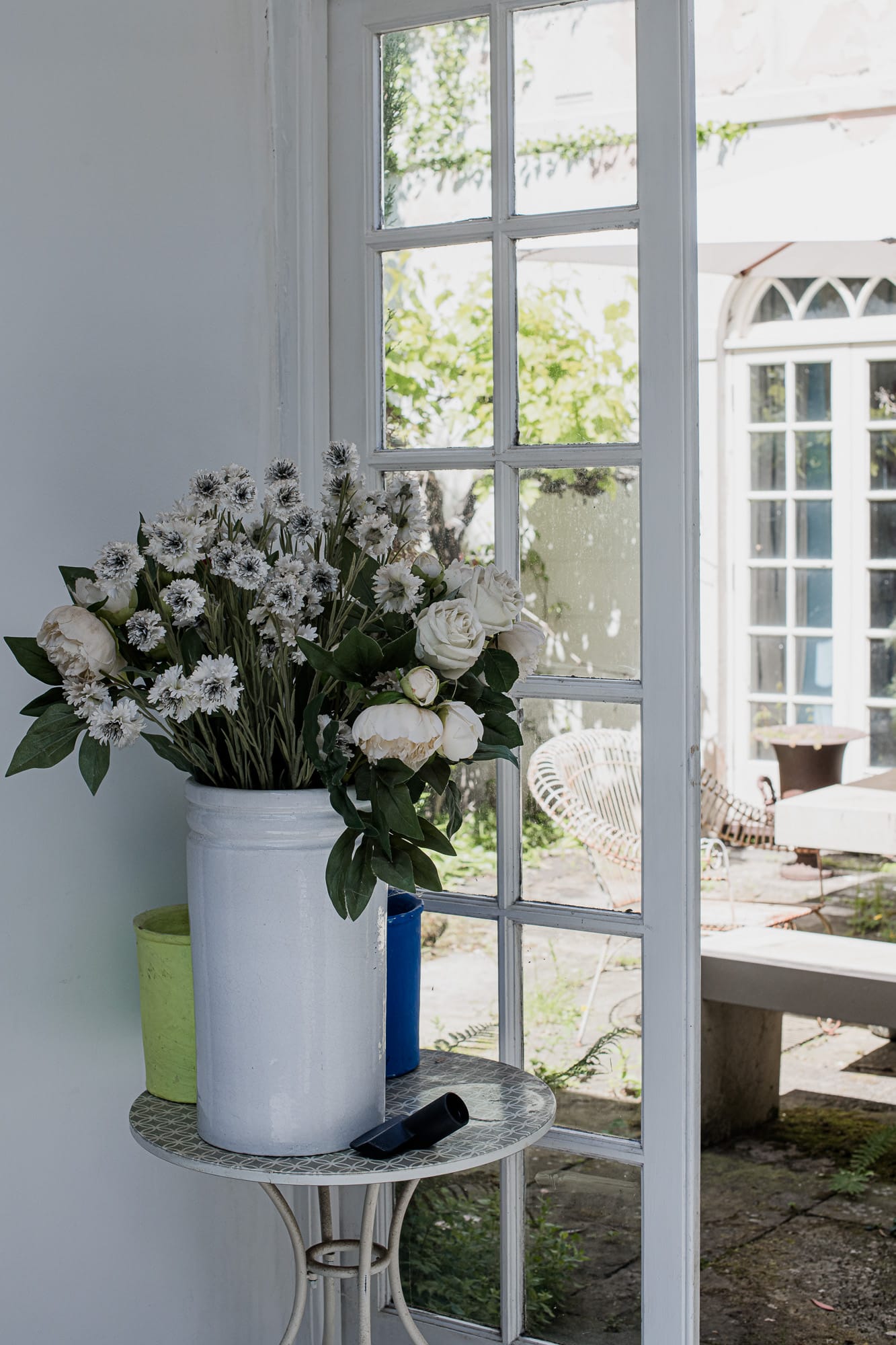
To subscribe and book your annual 5-day stay, visit LettsRetreat+ today and begin your journey to experiencing Mamhead Park South
It's been a busy summer for LettsGroup and its ventures. Its AI VentureFactory is nearly 6 months into internal release and with its first cohort of ventures. It supports the entire venture building process from idea to exit using the Innov@te methodology and its 7 core stages, 49 steps and 100's of sub steps. The software platform for early stage ventures and investors provides a suite of integrated apps, templates and tools with AI throughout. It is designed to double venture success rates, reduce the cost of venture building and scale ventures more effectively. Most recently the team have been expanding key processes in the platform, including deeper tech and automation from data to customer feedback to product enhancements, plus faster customer data to CRM and a new, developing approach to business planning, financial forecasting and investor marketing.
August was a breakthrough month for LettsCore. After going live on the public blockchain and across the IPFS, this new gen distributed media management platform is already logging faster 'read' times than traditional media with lower compute costs. Its first corporate customer is switching out of its traditional CMS platform and is fully connected to LettsCore's API's and began to roll out its first cohort of users. The engineering team delivered enhanced update speeds and rate limiting capability which led to a 10 fold improvement in both read and write performance. Its first customer is stress testing the platform with, initially, hundreds of users and thousands of content items. The team extended the SaaS dashboard to include a Public Content View, My Content View, Organisation Content View, Application Content View and Application and Organisation Setup - preparing for smaller and mid sized media customers to sign up and get going all online later in Q4.
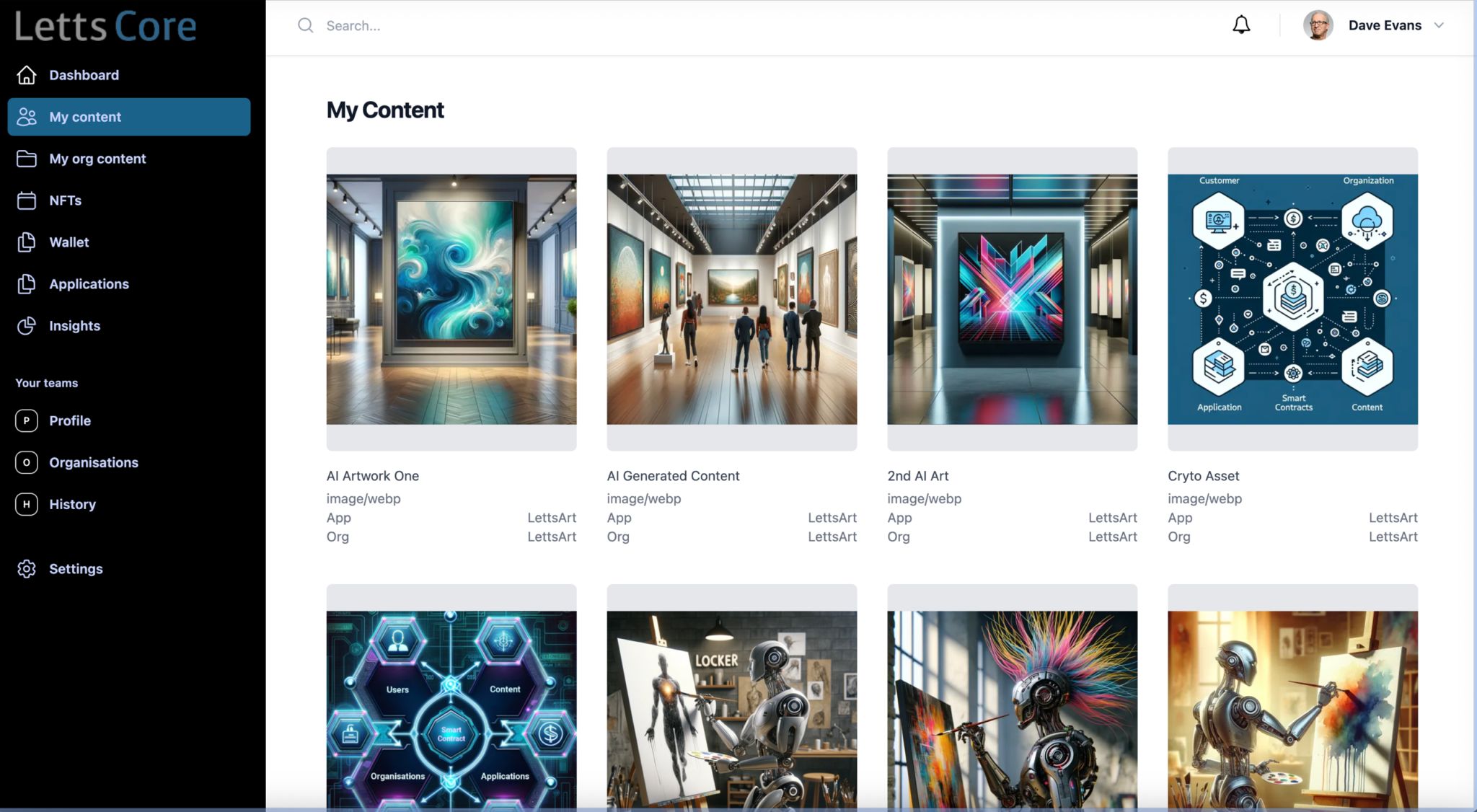
LettsNews' private beta is almost complete and ready to go live in public beta at the end of September. This new software platform to deliver advanced, cost effective newsroom tech to any journalist, content manager or publisher is already generating early revenues which is very positive. LettsNews 1.0 is basically complete having implemented subscription management, payments, team chat for each 'Content Item' or 'Story' and advanced search. The next few weeks will focus on UX and UI enhancements alongside final preparations and product performance prior to public beta. The LettsNews team have a clear vision to build a software company that can genuinely change the business process and economics of the news industry. It fundamentally alters the way in which news is gathered, published and distributed providing strong cost benefits and alternative revenue sources to its users.
9 months after LettsArt's market launch the art-tech venture is growing at quite a pace. Already 575 art galleries use its software to manage, distribute and sell art with more than 1 new art gallery signing up a day. This subscription based, no-code AI platform helps its users sell art more effectively, generating transaction fees for the platform. A growing number of galleries have already upgraded their subscription plan, building early subscription revenues. LettsArt 2, a major software upgrade released last month, is proving to be a commercial success attracting quality independent art and artist galleries and accelerating the process of building an online gallery with modern software to manage a professional, scalable art business. LettsArt 2 offers a host of new features including multi-art shows and sales, AI generated artwork descriptions, AI generated tags on artworks, AI generated posts based on featured art, AI generated art from text prompts and an upgraded AI help system. Galleries using LettsArt software have attracted over 1,200 collectors and even more followers. This burgeoning $550bn industry is in need of a technology driven shake up. LettsArt is well positioned to help make that happen.
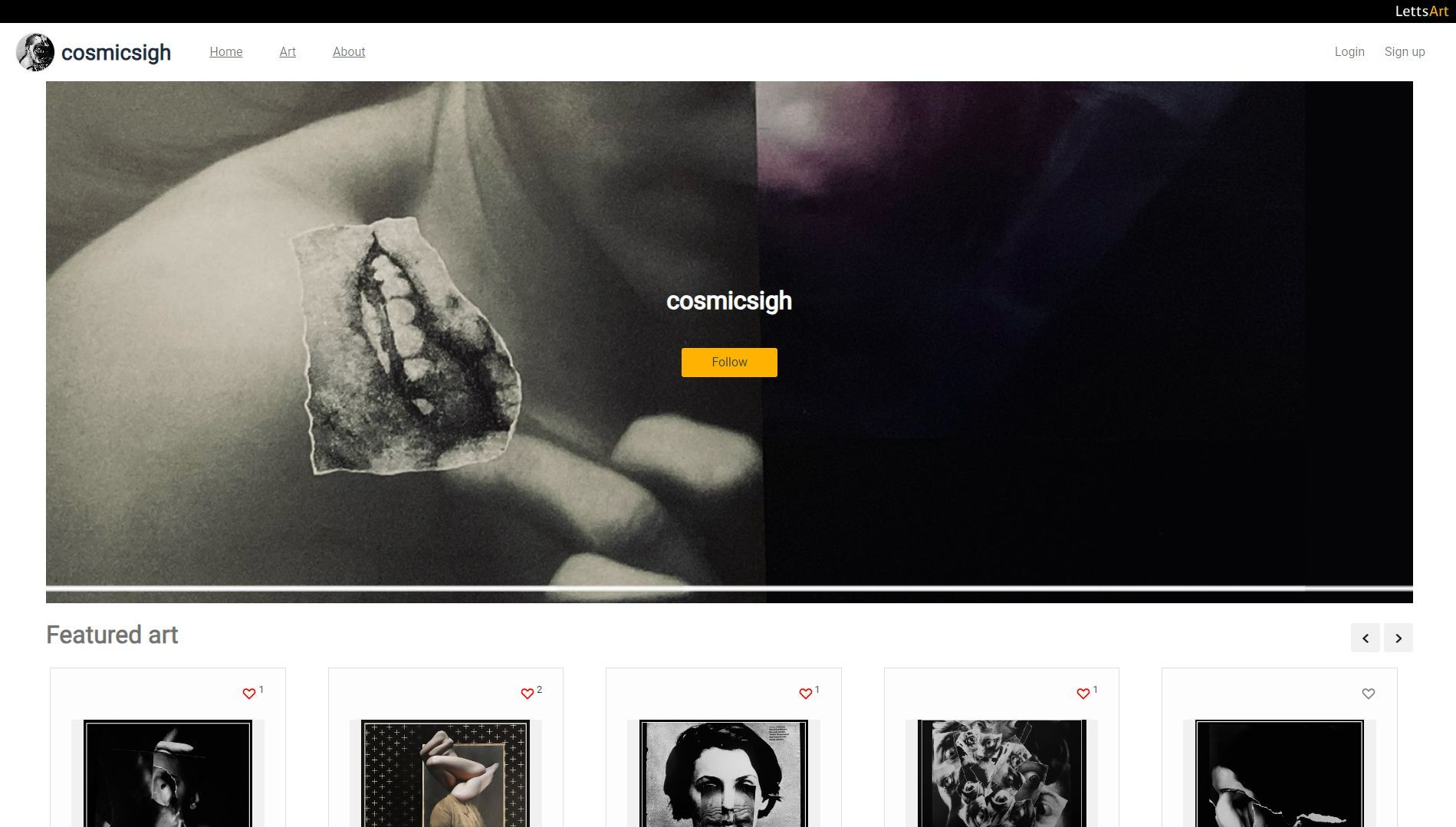
LettsSafari is out of extended beta and gearing up for its full market launch in October. This digital, subscription based climate venture has had quite an impressive beta launch attracting 600 subscribers with zero external marketing. Its promise of 'building rewilding safari parks with you' looks quite timely. The team's expertise in smaller-scale, mass market rewilding is unparalleled. We are excited about its new Company subscriptions and a higher tier 'Patron' offering for individual subscribers. Their technique for natural tree growth. planting for enhanced carbon storage and the very concept of eco wild spaces in miniature is quite alluring. Their established rewilding safari parks and gardens are a sight to see.
We highlight a few of our ventures in each monthly edition of The LettsGroup NewsFlash. To explore other LettsGroup ventures go to LettsGroup/ventures.
Two years ago, The Letts Journal, signed up to be part of a new project started by our mothership . It set out with the lofty ambition of making news pay for those writing the news. I know, shocking stuff. Journalism isn’t exactly known for great pay and while movies like All the President’s Men might make one think its glamorous the reality is there are only two Woodwards and Bernsteins. But now its obvious that the whole news industry had a major problem. It wasn’t just the individual journalist who couldn’t afford a decent whisky the paper itself could hardly afford the paper it was printed on.
Thanks to the likes of Google, Meta, TikTok and X the financial model for news publishing - advertising money - was well and truly broken. I mean news still makes money but the money goes to those tech behemoths not the publishers and certainly not the actual journalists. And its not as though the news itself doesn’t have any value. people still want to know whats going on. They just aren’t getting it as they used to. As a result the transition from print media to digital media is failing for all but a very few.
Most of the money goes to search and social media platforms that do not gather, write or edit the news. The independent journalists and news publishers who are doing and financing the actual work earn mere scraps left by these closed platforms. As a result local news is fast disappearing and traditional publishers are forced to deliver their own version of shrinkflation - less quality news costing increasing amounts of money for fewer readers. Quality, balanced news from a rich, diverse tapestry of news organisations is disappearing before our eyes. The less good side of AI is accelerating this trend.

There is an ever growing number of potential journalists out there - particularly when you factor in the explosion of freelance and citizen, social media journalists and influencers. At the same time, there are a growing number of places that distribute news including social media pages, private and public websites, platforms such as Reddit, Substack and Medium, and, of course, traditional media companies. And the tools to gather news have proliferated into the hands of billions of mobile phone users worldwide.
We got excited thinking about how things could change if we were to build a platform that offered powerful yet simple tools for gathering, publishing and distributing news stories to anyone that had a mobile phone. And earning money from all that work. The writers could sell their news items through the platform so people that gather news can make more money doing it. Like an Uber for news creators.
Today LettsNews launched in private beta. Access is by invitation only and The Letts Journal team enjoyed early access over the last month. It's now our default newsroom system. This article was gathered, assembled, published and distributed in LettsNews meaning that today we have more advanced tools to gather, curate and to auto-publish news items to multiple outlets - whether it's on the go, in the field or back in the news room. This makes us more productive as a team and helps us spend more time researching and creating great stories. We hope!
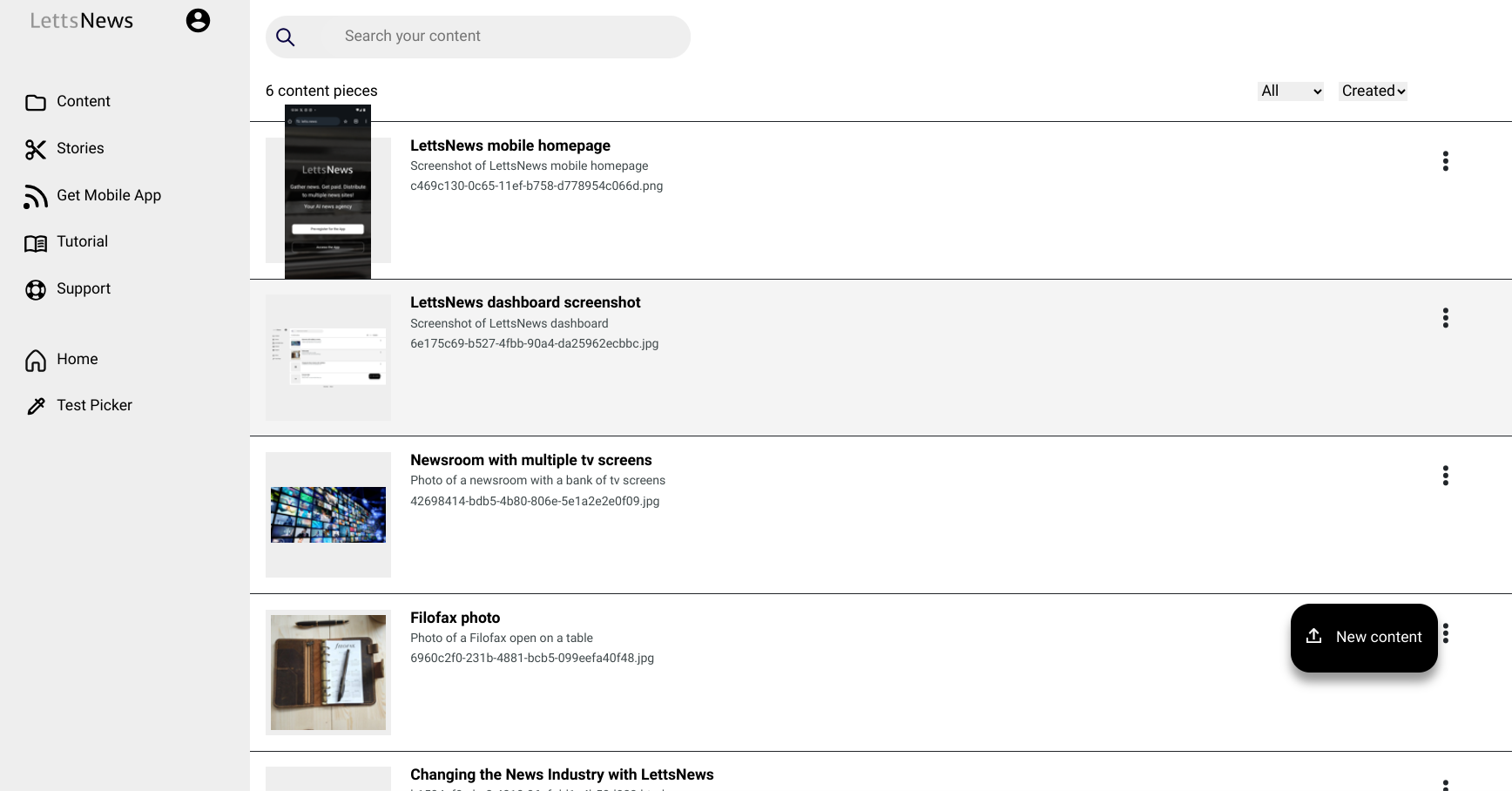
In LettsNews each news content item, whether it's words, images, video or audio is gathered, stored and managed in a powerful newsroom system that organises, tags and sorts the content - so we don't have to. To publish a story you just drop the news items into a story and then, when you're ready, file it so it can be edited separately and distributed at the click of a button. It can be auto-published to a wordpress site, to Medium, Substack, Reddit, social media or anywhere else you care to distribute it on the web. That way, you spend your time finding, gathering and writing great stories - not sorting, filing and distributing them. As a result of using LettsNews, The Letts Journal is no longer wedded to a single app, site or system. The silos have been eroded.
Their single user version is free and the Teams version (which is quite powerful) is great value at just a few dollars per month for a team of 5. LettsNews clearly wants to remove as many barriers as possible to getting their newsroom tech into the hands of as many media outfits and people as possible. They believe that we will struggle to democratise the news and stimulate diverse perspectives unless we remove as many of the existing barriers as possible - including cost.
As more journalists, writers and content creators use the new system they will not only gather their own news items as building blocks for more detailed news stories, but they will also be able to sell them through the LettsNews content marketplace (coming later this year). AI and advanced search will help users purchase stories, images, videos or audio pieces from the growing community of LettsNews users, helping to assemble a richer, deeper story. News articles could be built from a wide mosiac of specialist news items from expert photo-journalists, videographers and interviewers waiting to enrich your reporting and perspectives. This gives any LettsNews user access to the technology, real-time content and AI editing tools to enable them to operate their very own digital news agency.
LettsNews offers a mobile app (both iPhone and Android) for gathering content on the move and a Web app for more complex story building on laptop or PC. The two sync with each other effortlessy. You can do basic photo, video and audio editing in the app and easily upload content stored in other places to drop them into a story.
In an era dominated by rapid information exchange, the landscape of news reporting and dissemination is undergoing significant transformation. LettsNews emerges as a potentially simple, yet groundbreaking platform in this changing media environment, redefining how news is gathered, published, distributed and remunerated. Its innovative approach not only enhances the accessibility and diversity of news content but also empowers journalists and the general public in unique ways.
Its commitment to leveraging cutting-edge technology to facilitate a more inclusive and participatory news environment is quite compelling. The platform harnesses artificial intelligence (AI) and crowdsourcing, enabling it to process a vast amount of information rapidly. This technology will also enable LettsNews and its users to offer real-time news updates and diverse perspectives that traditional newsrooms might overlook.
By democratizing the process of news gathering, LettsNews ensures that individuals from different geographical locations and backgrounds can contribute to the news cycle. This inclusivity breaks down the traditional barriers erected by mainstream media conglomerates and social media platforms, which often control what news gets published and whose voices are heard. These algorithms for media control can get broken down. Murdoch's final epitaph?
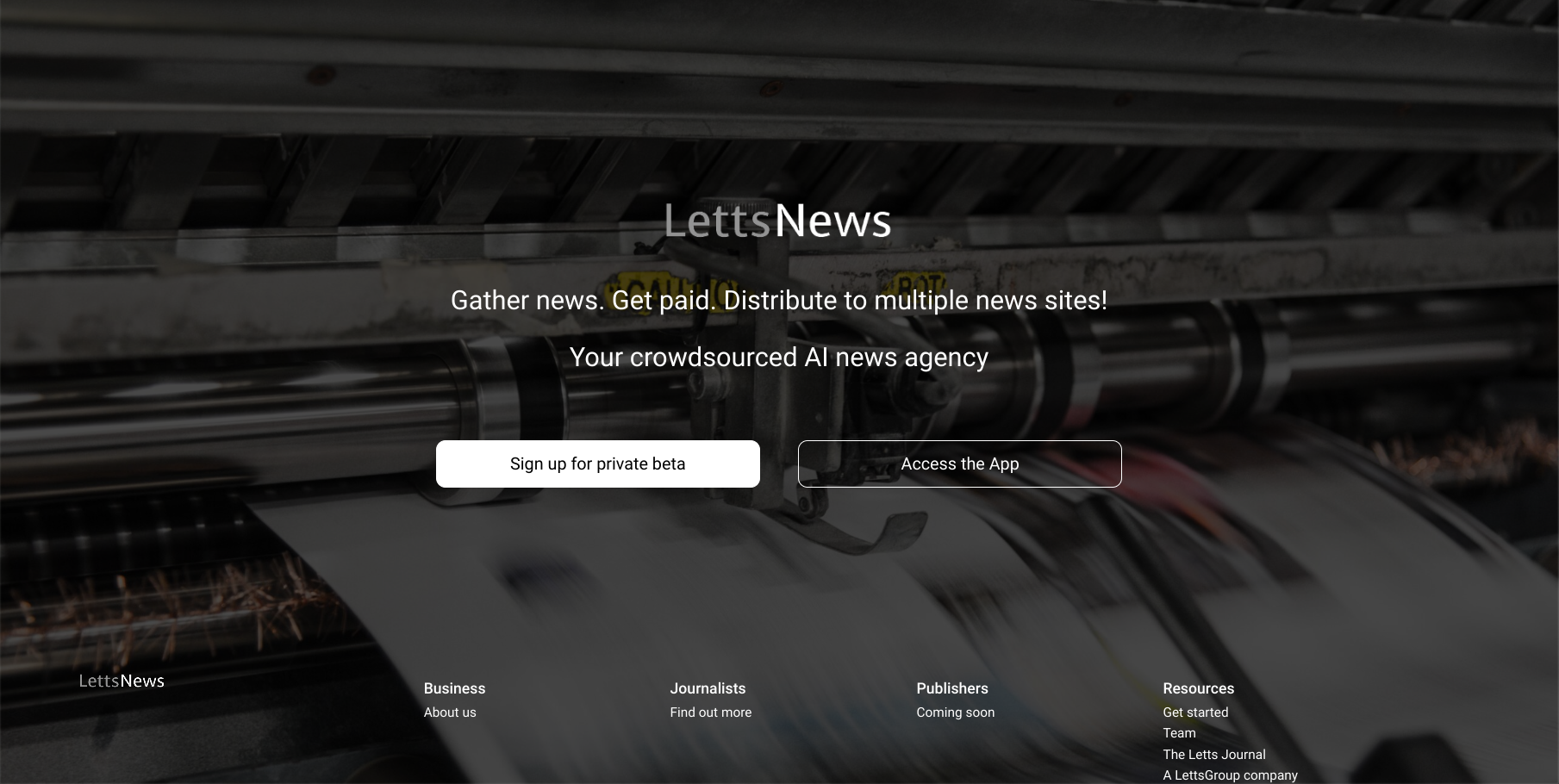
LettsNews stands out by empowering both professional journalists and citizen reporters. The platform provides tools that allow users to easily submit news stories, whether they are on-the-ground reports from amateurs or in-depth analyses by seasoned journalists. This approach not only diversifies the sources of news but also encourages a grassroots level of participation that is often missing in conventional media setups. LettsNews is also a powerful tool for business content creators and PR agencies. Indeed, the platform could integrate agencies, businesses and media outlets like never before. A new content process for a more digital age.
For journalists, it offers a model that could add significantly to the traditional ad-revenue and subscription-based systems. It enables content micro-payments helping journalists to gain direct support from their audience. This model not only provides financial independence but also encourages journalistic integrity and freedom.
LettsNews approach to the distribution of news could prove to be a game changer. The platform utilizes a decentralized distribution model, which contrasts sharply with the centralized control typical in the media industry. By distributing news through a growing myriad of channels and platforms, this new British outfit ensures that news reaches a broader audience and reduces the risk of censorship or bias that can occur when a few entities control news dissemination - going more directly from creator to outlet.
LettsNews also integrates seamlessly with social media and other digital platforms, making it easier for news to be shared and discussed among a global audience. This integration helps to keep the public informed and engaged, fostering a more informed community - God forbid... Sorry Donald.
LettsNews is commited to transparency and ethics in reporting. The platform is buildilng technology systems and will use AI for fact-checking procedures and ethical guildelilnes to ensure that news content is accurate and ulnbiased. Its comittment to truth is crucial in an age where misninformation can spread quickly.
It's still early days for LettsNews and we will keep you posted on how it progresses. You can pre-register for the private beta and get involved as they add more invite-only users in the coming weeks and months.
It looks like this initiative could build momentum towards a more democratic, inclusive and transparent media landscape. By empowering individuals to contribute to and control the news narrative, LettsNews is paving the way for a future where news is by the people and for the people. Its innovative use of technology, commitment to empowering journalists, and novel distribution strategies could make it a unique player in the news industry, capable of genuinely democratizing the way news is gathered, published, and shared. It's early days but the platform is already quite impressive. We would recommend it.
Innovation is one of those much hyped, painfully over-used words. Its right up there with disruptive and visionary. How does the saying go if I had a dollar for every disruptive, visionary innovation I’ve been shown I’d be a rich man. And, if that’s not bad enough, ‘innovation’ is further expanded by stratified terms like incubator and accelerator - words that are bandied about equally, almost without meaning, by poachers and gamekeepers - entrepreneurs and investors. Statistically, venture building is a veritable crap shoot with extremely low success rates. Far too many organisations fail. Perhaps it’s time for a different approach.
Apparently 90% of new startups fail. And 75% of venture-backed startups fail - proving that money is not the answer to everything and that venture capital firms have no magic wand/bullet/rocket - whatever they say. Further, less than half of businesses get to their 5th birthday. The highest failure rate occurs in the information industry proving that they don’t use their own products enough - assuming they’re worth using in the first place. Check Facebook.

There are a few organisations that are trying to move venture building from the small, one-off artisanal workshop, that it is today, to a more ambitious model, based on the creation of a ‘venture factory’. Venture factory pioneers believe they can consistently deliver higher quality, repeat innovation and higher success rates when it comes to venture building.
Before the full blown venture factory came along, we witnessed a virtual proxy called the ‘venture studio’, also known as a startup studio or a startup factory. This business model focused on systematically producing new companies. Unlike traditional incubators or accelerators, venture studios don't just support existing startups; they actively engage in creating new businesses. Some of the key characteristics of a venture studio include:
Venture studios can be efficient mechanisms for launching new companies because they can leverage shared resources, expertise, and processes across multiple startups. This approach should, in theory, increase the speed and reduce the costs of starting new businesses, though it does typically involve a trade-off in terms of equity and control for the entrepreneurs involved.
The venture factory goes beyond a venture studio by operating a full blown factory, tooled and optimised for its own branded ventures first - only subsequently thinking about becoming a contract manufacturer for 3rd party ventures (as well). Like starting up as Google and then ending up as, well, Google Ventures - only with a real factory this time!
The venture factory has a carefully designed virtual space, a manufacturing process and methodology, specialist assembly lines, factory workers, robots, tools, quality control systems, and, most likely, a warehouse and distribution network. All designed around building and shipping ‘ventures’.

For a venture factory to work it will likely need a number of core components:
Mach49, a growth incubator for large corporations (is that an oxymoron?) has a simple 4 step process which includes ideate, incubate, accelerate and scale. It recently published a book about it called ‘The Unicorn Within’, which is a nice read and great if you can get one. A unicorn that is.

LettsGroup takes a more detailed approach with its innovation and venture building methodology aptly named ‘Innov@te’. Their process has 7 key stages and 49 steps that provide the basis for a genuine, repeatable venture manufacturing system. Its 7 stages include:
This 65 page manufacturing style process manual is about as exciting as reading a Boeing flight safety manual. Both crash without them - it's just the stats are worse for venture failure than aeroplane disasters. Oh, wait…
The venture factory team at LettsGroup are working on turning Innov@te into a dynamic and structured manufacturing software system. Think of it like a traditional manufacturing production system for building innovative startups rather than physical products. Move aside Oracle, hello Innov@te VRP.
There are a number of different venture design approaches. Perhaps the best known is the Lean Startup methodology which is about putting a process and a methodology around the development of a product. It’s kind of like teaching your toddler to use an iPhone AND clean up after themselves.
The Lean Startup methodology believes that every startup is a grand experiment that attempts to answer a question. The question is not "Can this product be built?" Instead, the questions are "Should this product be built?" and "Can we build a sustainable business around this set of products and services?" They believe that this experiment is more than just theoretical inquiry; it is a first product.
It is about starting with a very narrow concept designed around solving a niche and specific customer problem. Entrepreneurs are meant to launch a minimum viable product (MVP) which is an initial straw man that a few somewhat geeky early adopters might help shape into a real live product after a bunch of data driven iterations - assuming that the hard charging, gun toting entrepreneur has the patience for all these iterations and data analysis.
Lean believes that “Startups exist not to make stuff, make money, or serve customers. They exist to learn how to build a sustainable business.”

Over at LettsGroup they designed their own ‘Size Zero Philosophy’ which seems to be a broader, more structured approach to thinking about a highly efficient and automated enterprise. Their manual helps to design a focused, sustainable and more cost controlled, scaled enterprise from a small startup. Or, embeds a lean, more agile design into a larger corporation. Their Size Zero philosophy runs in parallel with Innov@te, their venture manufacturing process. Combined they could prove to be a new Kanban or a ‘Just in Time’, flexible method for venture manufacturing. Try getting your head around that one!
Apparently a true venture factory operates an advanced software system from their venture building process or methodology. It sounds a bit like fashioning ‘the Theory of Constraints’ manufacturing optimisation system from a simple book ‘The Goal’ - which actually happened and was first written by Eliyahu M. Goldratt in 1984. Today it is in its 3rd edition.
In the same vein it looks like advanced venture factories will develop their unique process and methodology into a complex manufacturing system and a set of defined, standardised software tools that are used not just to build the venture but to operate and manage it sustainably over time. AI and automation will accelerate these systems and, as a result, the very concept of repeatable, sustainable innovation.
Venture factories will likely think beyond the venture’s initial product launch and devise extended processes and systems for the longer term development of the venture and universal, scaled distribution systems for the scaling of their ventures.
For example, LettsGroup has developed their own proprietary Web3 content management system providing highly scalable content based verification, micro-monetisation (which is micro-payments on steroids, fully embedded in the content!!) and syndication. This looks like it could become a veritable warehousing and distribution platform for information industry ventures. Meaning we don’t just build it but we can sell it as well!
It might end up that the advanced venture factory of tomorrow will initially get built and operated to manufacture branded ventures that are owned and created by the venture factory owner - as Ford developed the car assembly line for their own branded cars. But, once these venture factories mature and scale it is likely that contract factories will emerge to create, build and scale ventures for 3rd party customers like venture capital investors, funds and global corporations.
Like today the iPhone is manufactured for Apple by Foxconn in places like China, the Czech Republic and South Korea. Tomorrow venture factories from the likes of LettsGroup and others could manufacture new contract ventures for Amazon, Apple or Blackstone with the simple premise that ventures built by them will last longer and experience a success rate greater than 1 in 10. Perhaps successful, repeat innovation is not as far away as it seems.
This article first appeared at The Letts Journal.
A new breed of more involved venture capital is developing to help support start-ups and growth companies in a more structured and elaborate manner. Some call it ‘operational venture capital’ proving at the very least that venture investors should stay away from new naming conventions.
Where venture capital typically plays an important role is the period in a company’s life when it begins to commercialise its innovation. The vast majority of the money invested by venture capitalists goes into building the infrastructure required to grow the business - in expense investments (manufacturing, marketing, and sales) and the balance sheet (providing fixed assets and working capital).
Venture capital’s niche exists because of the structure and rules of capital markets. Someone with an idea or a new technology often has few other institutions to turn to. Usury laws limit the interest banks can charge on loans, and the risks inherent in start-ups usually justify higher rates than allowed by law. So bankers will only finance a new business to the extent that there are hard assets against which to secure the debt. And in today’s information-based economy many start-ups have few hard assets, while at the same time, few young entrepreneurs can afford to buy a house for the bankers to wrap their somewhat grubby paws around in the glorious name of ‘collateral’.
Venture Capital therefore fills the void between sources of funds for innovation (chiefly corporations, government bodies, and the entrepreneur’s friends and family) and traditional, lower-cost sources of capital available to ongoing, proven businesses. Filling that void successfully requires the venture capital industry to provide a sufficient return to attract private equity funds, attractive returns for its partners, and sufficient upside potential to entrepreneurs to attract high-quality ideas that will generate high returns. The challenge is to earn a consistently superior return on investments in inherently risky business ventures. A challenge that you could argue is a little oxymoronic. But, then again, entrepreneurs do it every day of their life so who’s counting.
The original idea that the entrepreneur is the modern-day cowboy, roaming new industrial frontiers much the same way that earlier Americans explored the west is a vision that is starting to wilt on the vine. At the entrepreneurs side stands the venture capitalist, a trail-savvy, Tonto-style sidekick ready to help the hero through all the tight spots - in exchange, of course, for a not small slug of the pie.
Yet today’s entrepreneurs look more like Harvard MBA’s and venture investors look increasingly like Wall Street bankers. Some think this will lead to more empty suits and fraudsters and Sam Bankman-Fried’s than romances made in money-making heaven.
Others argue that it's more than ever going to lead to quickie divorces rather than investor bromances. After all, venture money is not long-term money. The idea is to invest in a company’s balance sheet and infrastructure until it reaches a sufficient size and credibility so that it can be sold to a larger business or so that the institutional public-equity markets can step in and provide liquidity. In essence, the venture capitalist buys a stake in an entrepreneur’s idea, nurtures it for a short period of time, and then exits with the help of an investment banker faster than you can say “show me the money”.
The problem is that a number of quality entrepreneurs want more than just money as they march tirelessly and lonesomely through the venture building process, so they might not want an empty suit with a hack load of promises and a half open wallet. They might, in this increasingly ESG universe, want something a little deeper, a little more dare I say, ‘meaningful’.
“Remember, investors will offer entrepreneurs all sorts of things and likely deliver none of them. They only have to deliver one thing - a cheque!” The famous words of venture capital legend Bill Draper III rang deep with our editor.
It seems Bill Draper, probably the first venture capitalist, summed up the essence of the venture capital industry by stating that these investors were not, in fact, partners to the entrepreneur but merely private company, early stage fund managers. And like public company fund managers from Fidelity, BlackRock or Schroders they’re more analyst than operator. They are there to make money out of the entrepreneur and not there to ‘buddy up’ Tonto-style or ‘make a goddamned difference’ to the universe aka Steve Jobs.
Unfortunately some of the great entrepreneurs like to make a difference. Call it the Napoleon syndrome or the youngest child syndrome or simply if-I’m-gonna-give-up-my-life-my-sanity-and-my-money-there-had-better-be-some-deeper-meaning-to-it!
Either way, apparently there are a decent number of entrepreneurs that want more than just a number crunching, cash accounting, financial analyst for their venture partner - they want something a little deeper than that. They’re looking for their very own Jerry Maguire. And who wouldn’t want a small piece of Tom Cruise.
As a result a new breed of ‘operational venture capital’ companies have emerged. Firms like Project A, EQT Ventures and others including a16z and GV (formerly known as Google Ventures) in the US. They have a combination of investing specialists and operational consultants that widen the entrepreneurs team in areas such as HR, talent, data, sales and marketing.
These operational VC’s on top of their investment, give you access to their people - often only if it is needed. It’s more like a menu. You know, that sales pitch “if you want to work with us, you can”. Except, an investor that has a large stake in your company and likely a board seat is not necessarily the most passive partner in real life. Pure play VC’s would suggest that if you utilise their ‘no operational strings attached’ money you can go and hire the best specialist advisers in the open market - not just shoe-in the ones that they employ.
In the ‘operational venture’ model the philosophy is that if you genuinely think you’re investing in a groundbreaking company you will need to spend at least 90 percent of the time working for the benefit of the entrepreneur, not the other way around. It sounds easy enough, but it isn't. Unless, of course, you really are Tonto in real life.
It could be that this hybrid ‘operational VC’ approach does not go far enough to really make the difference. The Letts Journal’s mothership, LettsGroup, addresses this with its ‘branded venture group’ approach which combines a new style IP focused conglomerate with an operational venture outfit. They are not afraid to back their own ideas and staff their ventures until the product-to-market fit is more evident and it can attract quality outside capital. It’s like a private equity approach to earlier stage venture building.
The folks at LettsGroup believe that current technology investment models are broken; too much money is wasted on too few innovations reaching either maturity or delivering real impact. They believe that it’s time to change the model to a more predictable, repeatable process that ensures innovation happens faster, and delivers greater social impact. They have their own methodology, resources and technology. Kind of like a Kanban continuous improvement system but for innovation. A counter philosophy to the 1 in 10 high roller casino approach taken by traditional venture capital firms.
Whichever direction the venture capital market is headed the options for finding alternative capital for quality start-ups keep widening - even in these crappy markets. Indeed there are more angels, family offices, alternative debt models and funds than ever chasing the next best idea. And the desire to find and back the newest goldmine is as old and entrenched as the west coast dust fields.
Technology is only getting better at auto-matching pools of money with interesting start-ups. So much so that WALL-E could become your next VC! This means that professional venture investors might have to get better at offering more than just their money. If even McDonald’s can create a full-service, fully automated offering then surely venture capital outfits can up their game.
This article was originally published in the Letts Journal.
LettsGroup is a branded venture group, providing operational assistance to its ventures, including LettsArt, LettsSafari, LettsCore and many more.
From its family history with the diary to deep tech - LettsGroup is driving UK innovation in the 21st Century
The eponymous Letts diary family started probably the world’s first corporate incubator in 1796, famously inventing the commercial diary in 1812 while launching a slew of paper based products including calendars, notebooks, ledgers and more. 5 years ago the all new LettsGroup, the UK branded venture group, green-lit 5 new ventures and kick started its unique branded venture approach.

Today LettsGroup, run by Philip Letts, the 7th generation of the Letts diary family, is using advanced technology and its unique incubator methodology to solve some of society’s biggest problems. It focuses on building next generation technology, media and climate ventures that deliver high growth and sustainable earnings. The new group is unified by its brand, its family heritage and its desire to do good while creating value over the long term.
The original incubator that John Letts started in 1796 created innovative branded products that utilised the technology of the time - the Gutenberg press. He mastered the printing press and coupled its power with leather-bound and sometimes gold embossed wonders of stationery.
Today, in the digital age, LettsGroup is powered by its own technology innovation aptly named LettsCore - think of it as a Gutenberg Press for the post information age. LettsCore is a Media-as-a-Service (MaaS) innovation that could transform the way we manage and even think about content. Initially it is focused on solving content’s biggest problem - trust and verification - due to its lack of embedded provenance. An inability to determine the reputation or even the origins of the information. LettsCore's content management blockchain is designed to fix this.
Added to this, generative AI explodes this content provenance crisis, making the case for LettsCore even more pressing. The wide-ranging problem that LettsCore seeks to solve was discussed by Google’s Vice President of News, Richard Gingras, at the World News Media Congress in Taipei.
"Will the many available generative AI tools further facilitate the creation of misinformation and disinformation? Assume they will. That should not surprise us. The Internet does fully enable the breadth of free expression as codified within the world’s sovereign domains — from awful to lawful.
Yes, determination of the provenance of content, whether it be an image or a paragraph, will be key. In most cases, the more useful path will be determining the reputation of the source publishing that information. What signals measure a source’s reputation? How does context impact that assessment? How might we detect patterns of endorsement or, conversely, patterns of coordinated disinformation behavior?
This impact of generative AI on disinformation will add further urgency to regulate such behavior — which will engender its own set of challenging consequences."
LettsCore’s technology is truly profound, and it has been years in development. Its first commercial use will be with another LettsGroup venture, LettsArt, to seamlessly distribute its users works of art across the internet while ensuring that the content is secure, attributable and tradable. This will help its Web3, no-code art website platform users, both creators and gallerists, to expand their reach and potential sales channels at the push of a button.
Philip Letts, Chair of LettsGroup added, “We are excited about the first commercial application of LettsCore and its ability to bring truly distributed content monetization and provenance in the fragmented, wild west of visual content we are experiencing on the internet today.”
Another LettsGroup venture, LettsNews, is looking at adopting LettsCore to implement atom level author attribution to news pieces at considerable scale. LettsNews is a crowdsourced AI news platform that helps consumers find high quality, more democratised news in a world where publishers are employing fewer journalists and reporters lack diversity of income. LettsNews’ groundbreaking news media marketplace will increase the earnings for modern news reporters.
LettsCore will come to the wider enterprise market in the second half of 2024, helping content to become more transparent and attributable in a world that is increasingly plagued by misinformation, disinformation and misappropriated content.
The first generation of the Letts family, back in the late 1700’s, used the Gutenberg press in new and interesting ways to drive the first wave of its innovative products. The 7th generation of the Letts family with the all new LettsGroup is betting on its own invention, LettsCore, to power it through the current century.
LettsGroup is a branded incubator group, which is active through @LettsGroup on twitter.

LettsGroup is revolutionising the venture model with advanced technology. Today, technology leadership is a huge determiner of economic and global dominance. LettsGroup is at the forefront, investing in deep tech and pioneering innovative solutions that will shape the future of society and economies.
Led by Philip Letts, the 7th generation of the Letts family and Executive Chair of LettsGroup, the company is equipped with a long-standing family legacy of innovation, and is now combining it with cutting-edge technology to create a systematic approach to venture production. They have two guiding principles and methods to achieve impact in venture building.
First, the Innov@te™ methodology uses a customer-centric approach. It places the customer at the heart of the innovation process. Through tight-loop systems of curation that involve data collection and behavioural analysis, LettsGroup ensures that its ventures are built to meet the needs and behaviours of the target audience, resulting in a higher chance of successful adoption of their products in the global market.
Second, their Size Zero methodology addresses the traditional notion that getting "too big" kills innovation. Instead, it focuses on efficiency and control in scaling ventures, providing a solid foundational structure for sustainable operations. The unique combination of methodologies allows LettsGroup to achieve repeat innovation and sustainable venture building, setting a new standard in the industry.
"LettsGroup is committed to pushing the boundaries of the venture model by leveraging advanced technology and deep tech investments," said Philip Letts, Chair of LettsGroup.
"In today's dynamic global landscape, technology leadership is a key determinant of economic and societal success. We are dedicated to investing in innovative solutions that will shape the future and drive ventures to the top of the global power rankings."
LettsGroup has already made significant strides with its initial ventures. LettsArt, the first NFT-enabled, fully accessible, website platform designed purely for the art world, has quickly gained traction, providing a new way for artists, art dealers and collectors to engage with and better monetize online audiences. LettsSafari, a subscription-based digital climate venture, has also gained momentum in addressing the biodiversity crisis through rewilding initiatives that are defining subscription economy eco-services. Additionally, LettsGroup is developing LettsNews, a fully automated, AI powered news network, and LettsCore, a groundbreaking Media-as-a-Service platform that is creating the first content blockchain.
As LettsGroup marks the 3rd iteration of Letts family incubators in 2023, it continues to redefine the venture model with its innovative approach, looking to drive ventures to develop industry-first practices. The company remains committed to its corporate values of innovation, sustainability, quality, integrity, and family, and aims to make a lasting impact in the world of venture building.
Subscription-based services are changing the game for ecommerce, media, and streaming industries. LettsGroup is paving the way, adopting subscription services for an array of its own ventures.
The evolution of technology has affected human behaviour and shifted business operations and competition accordingly.

Subscription models have seen consistent growth and pickup by businesses as large as Unilever and Walmart as well as many startups and small businesses.
Over the last decade, the subscription ecommerce market has experienced meteoric growth. According to Forbes, there’s been 890% expansion since 2014. Currently, there are 18.5 million subscription box shoppers in the U.S. and 35% of these active shoppers subscribe to three or more services, with a median number of subscriptions per active subscriber being two.
According to Hitwise, the average demographic of this consumer is a younger millennial with a college degree that lives in a college town with an income above $100,000 (£75,000). They are also often an Amazon shopper, a regular reader of online news and more likely to buy online than in-store.
There are three broad types of ecommerce subscriptions:
Replenishment subscriptions (32% of subscriptions) - which allow consumers to automate the purchase of commodity items, such as razors or diapers.
Curation subscriptions (55% of subscriptions) - that attempt to surprise and delight by providing new items or highly personalised experiences in categories such as apparel, beauty, and food.
Access subscriptions (13% of subscriptions) - pay a monthly fee to obtain lower prices or members-only perks, primarily in the apparel and food categories.
The future looks bright for the recurring revenue leaders.
More relevantly, subscription-based media is a major game-changer. With news media diving head-first into the digital world, ad revenues and circulation have been in decline, and an endless series of cost cutting and transformation plans has led to the industry stabilising around paid subscriptions. LettsGroup’s own The Letts Journal has been at the forefront of subscription-based systems, solely reliant on digital circulation with paywalled systems for revenue as an ad-free service. And, based on demographics alone, the internet paywall is becoming a key part of the future of profitable digital content circulation.
While newspaper staff numbers keep falling and print circulation declines, digital media is growing. Based on publicly traded companies, in 2020, ad revenue for digital newspapers stood at 39%. Digital newspapers share of ad revenue has been steadily climbing, as in 2011 it had accounted for just 17% of ad dollars. The trends are similar across the western world. Digital, subscription-based media is here to stay.
The increasingly dominant subscription economy will get tested as we have headed into its first major economic downturn. The effects could be hard to predict, but while the upward trajectory is bound to continue, the likelihood is that short term pressures will dampen new sign ups. Ultimately the sector will probably consolidate around 2-3 leading players in each category. While this could be bad for consumers and content producers, there is an emerging category that could point to the future.
It seems that creators are taking the subscription economy into their own hands. A number of paywall based newsletter platforms have emerged for independent writers and media startups enabling them to charge subscriptions to niche audiences. Some, such as Bankless, have developed subscription audiences in the hundreds of thousands. LettsGroup’s website system for the art world, LettsArt, provides a subscription-based platform for the art world and is free for artists. Artists can easily buy and sell their pieces, in a way that fully enables them to take complete control of the process.
LettsGroup has also launched one of the first online eco-services platforms for the subscription economy called LettsSafari. Environmentally conscious subscribers pay so that trees get planted, wild animals released and new rewilding safari parks are created and supported.
Just as new platforms will drive the emerging creator economy, we can expect Web3, including crypto, NFT’s and the metaverse, to shape big media over the next decade alongside other key technology developments like AI - all of which are factors LettsGroup will account for in the development of incoming ventures. The drive to digital is likely to become pervasive and, if so, micro payments should finally take off. A few cents for a media snippet supported by ads could prove to be an attractive alternative to the limited number of subscriptions we might be willing to sustain.
This article was first published in the Letts Journal.
LettsGroup is a branded incubator group, which is active through @LettsGroup on twitter.
LettsGroup unlocks repeat innovation methodologies out of a historical family
business model - the first of its kind.
LettsGroup, the family-run branded venture group, has become the first to crack the code to repeat innovation, following the release of the 3rd edition of the company's methodological framework, Innov@teTM. The tried-and-tested approach is a pivotal breakthrough in the world of innovation, thus allowing a model that codifies and ensures consistent venture production.
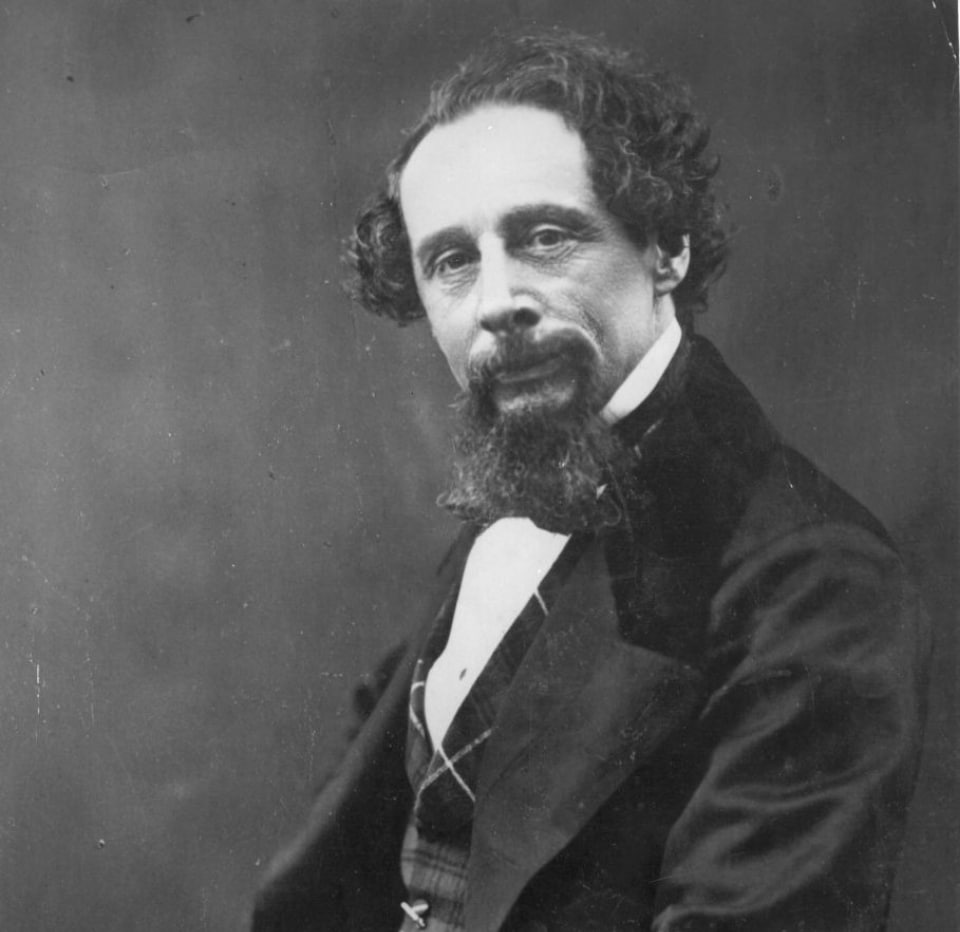
“Using our proven incubator methodology, and advanced technology, we solve some of
society’s most pressing problems,” Philip Letts, Chairman.
In 1796, John Letts built the world’s first corporate incubator. John Letts’s incubator developed a series of successful innovations including the first commercial diary, the Letts Diary. Further innovations included interest tables, specialist clerical and medical diaries, calendars, parliamentary registers, ledgers, and logbooks.
Now, in 2023, LettsGroup marks the 3rd iteration of Letts Family incubators, with its Executive Chair, Philip Letts, the 7th generation of the eponymous diary family. The world’s oldest corporate incubator has cashed out their invention of the diary, and cashed in on providing sustainable, repetitive innovation and venture building.
“It seems we are all becoming entrepreneurs. And yet no one has cracked repetitive
innovation,” Philip Letts, Chairman.
A series of corporate and innovative expertise has thus led to the establishment of LettsGroup. From LettsGroup’s tried and tested methodological approach, innovation can be a codified, patterned stream of service. Heavyweight international technology leaders have unified to support the growth of the branded venture group, including previous senior leaders of O2, Oracle UK and Ireland, EDS International, UBS, Broadview International, and Silverpeak. The team is littered with expertise in the cutting-edge world of innovation and tech.
LettsGroup is breaking through the market with a number of initial ventures, with the aim to establish a ‘Unicorn’ venture by 2030 - with the help of renowned tech investors. To highlight, these ventures include LettsArt, the first NFT-enabled, fully accessible, Web3 platform for the art world; and LettsSafari, the subscription based digital greentech platform that tackles the biodiversity crisis by expanding rewilding initiatives.
“Behind the scenes we are building a fully automated news network called LettsNews and
LettsCore, a groundbreaking Media-as-a-Service platform,” Philip Letts, Chairman
The methodology at the core of LettsGroup is Innov@teTM. Innov@teTM is the modern and extended approach of John Letts’ original incubator. Additionally, LettsGroup is in the business of repeated, technologically advanced, and sustainably conscious innovation. The methodological approach behind LettsGroup is the code to unfolding further new ideas to become projects, products, and ventures. Ford cracked the code for mass production. LettsGroup is cracking the code for innovation. More precisely, cracking a new innovation and venture every two and a half years.
But LettsGroup is not in the business of just throwing money and huge sums at problems or innovation. Its Size Zero methodology, accompanying Innov@teTM, presses Letts' theory that getting ‘too big’ kills innovation.
Both philosophies set out a necessary foundational structure to the successful operations of an ‘organisation’ for innovation, LettsGroup.
Where the family ventures, their simple philosophy follows, placing the customer at the heart of innovation. LettsGroup extends and optimises this philosophy, ensuring the customer is centre much earlier than in typical innovation processes, where many assume the centre to lie solely with entrepreneurs and inventors. This process is upheld further through tight-loop systems of curation, for which customer data collection and behavioural analysis is at the foundation.
Even more central to the corporate incubator is its seasoned founder, Philip Letts. The Chairman has over thirty years of experience in innovation, launching his first private incubator, Prophete, in 1997. From Prophete came Beenz - the earliest iteration of a crypto currency, boasting more than 6 million customers before its sale to Carlson Group companies.
Prophete was the first test of the Innov@teTM methodology. From Philip Letts’ second private incubator in 2006, The Visual Studio, came Maistro Ltd. Once again, the innovation was a breakthrough in the creative services marketplace, taken public in 2012. Furthermore, from The Visual Studio came Size Zero, a methodology handbook published in 2015 to guide young ventures to scale with
greater efficiency and control.
The company boasts the corporate values of innovation, sustainability, quality, integrity, and family. Led by the Letts family and managed by established industry leaders, LettsGroup is combining innovation with tackling the issues of society today, placing environmental consciousness at the forefront of these values. Its integrity is derived in its stance that no innovation supported by the incubator will be without deep considerations of sustainability, a pledge the Group has and will continue to uphold.
While just at its infancy, the branded incubator has produced its first, emerging ventures. Also a number of tech-centric ventures are being developed within the incubator, with LettsGroup producing a factory of new ideas, and a code to repetitive innovation.
Remote working, Web3 and AI could be changing the management game - LettsGroup is paving the way for venture capital innovation.
Management is changing, and LettsGroup is at the forefront. Remote working, Web3 and artificial intelligence (AI) will fundamentally alter the way organisations operate, meaning a call for change from organisers who are having to keep up with a world led by digital natives and cooperative work styles. Also for LettsGroup, these changes are marked by each ventures’ technological advances to establish platforms that are up-to-date, smoothly run and accessible.

The definition of management is in a state of change. Once defined as ‘the act of getting people together’, a generation makeover has dubbed a new definition to ‘gather people remotely’. Management is becoming first and foremost about organising and managing systems, with the people having to come second - likely requiring a new breed of managers to make it work.
Most standard definitions about management pontificate about organising people, resources and budgets to meet specific targets. Required skills include planning, strategy, budgeting and people management. This all made sense in the twentieth century. However, it could make increasingly less sense as the 21st century unfolds, as we switch from a people-centred view of management to a system-centric approach. Businesses that are successful are digital.
Tomorrow's organisation will likely be 100% remote, 100% digital, fully automated. Lean, innovative and fast. An approach LettsGroup intends to emulate across its venture portfolio.
The traditional manager is often considered a barrier to younger employees’ progress and growth. Where digital knowledge is lacking amongst an older management team, strategy and company growth wanes. Thus, management today needs experienced technology experts and a drive to adopt new technologies. LettsGroup CEO, Philip Letts, offers a host of experience within the tech venture world, running prosperous start-ups such as Beenz and Tradaq, which made waves in the world of digital - pioneering cryptocurrency and defi. Therefore, the team at LettsGroup contains many established, high-profile technology developers who are hungry to apply new digital innovations to their work.
As is reflected in LettsGroup’s company culture, the future style of management is shaped by the switch to remote working. Managing remote resources requires a fundamentally different approach as technology takes the lead and ‘organising’ experiences a reboot. Also, the latest systems for communication, planning, project and process tracking are rolling out. For LettsGroup, Zoom is just the first step.
If there was any doubt about the switch to remote, Findstack offers some sobering statistics:
Remote working operates most effectively when each team member assumes full responsibility for themselves and the team communicates effortlessly with each other. An almost self managing entity. The principles that we have adopted by working with customers remotely over the last few decades also need to be applied internally. For LettsGroup, transparency is everything. Transparency through systems. And tight, highly productive teams full of 'leaders on the pitch'.
If managing remote employees might be better suited to the newer, more flexible and digital generation, then just wait for the transition to Web3 and AI. The former is challenging the very heart of organisational structure while the latter will automate practically any task worth doing.
Today, LettsGroup is indulging in the future. By adopting a 100% remote working policy, developing Web3 innovations and embracing digital steps forward in NFT-enablements, the venture builder has only scratched the surface of its ambitions for advancements.
This article was first published in the Letts Journal.
LettsGroup is a branded incubator group, which is active through @LettsGroup on twitter.